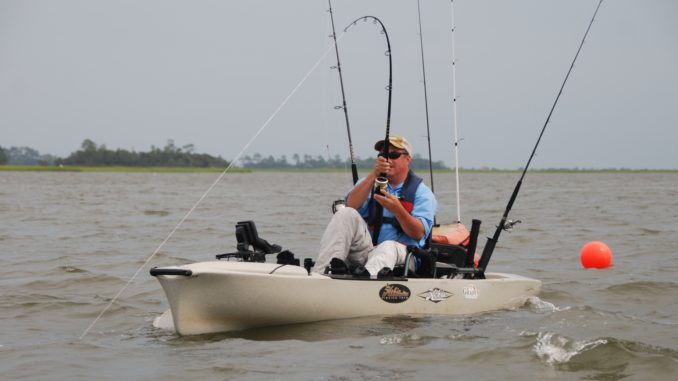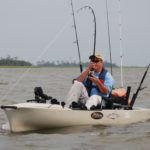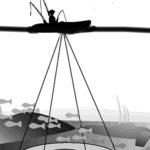
My high-school basketball coach, David Riggins, always avoided the old cliché that “Practice Makes Perfect.” Instead he would say, “Practice Makes Permanent,” and if pressed to say something regarding perfection he would say, “Perfect Practice Makes Perfect.” In a relatively solitary sport like kayak fishing, it’s hard to think of practicing anything. You want to go fishing, go fishing, but Coach Riggins’ logic still applies.
If you fish the same way today you did yesterday, your “practice” becomes more a standard part of your routine, which is fine if that practice is catching fish, but what if you could catch more or bigger fish or otherwise up your game if you changed up a few things?
While far from “perfect,” here’s a few tips that will make you a better kayak angler if you add them to your play list between now and this time next year.
• Fishing into the wind. Probably the most-difficult scenario when fishing from a plastic boat is when the wind is in your face, and there’s some speed behind it. If you let off the paddle or the pedal, your boat is going backwards, taking your away from your target.
To combat the wind, there are few ways to hedge your bet. First, have a quick and quiet way to park the boat on the spot. If that’s a stake-out pole or a bow-mounted anchor or a brush clamp, take the time to paddle up, position the boat, then make that first critical cast. Avoid the temptation to paddle up, drop the paddle and throw a Hail Mary that is more likely to wind up in the brush or weeds or whatever makes that spot so desirable.
When you do make that cast, a simple, sidearm motion low to the water with enough weight to reach your target will reduce the effects of a hard wind
• Fishing in the cone. Targeting deep-water targets is nearly impossible because you cannot get a visual reference on them. In this situation, kayak fishing becomes more like a video game. If you don’t already have one, obtain and mount a sonar unit on the strong side of your kayak where the transducer is located, a rod length in front of the seat. Make sure that unit allows a decent view of fish, bottom structure and is sensitive enough to graph your bait as it descends in the cone of the transducer.
Without going into detail, most units will read in either an 8-degree or 20-degree cone. Make sure you understand which one you are in and why. Becoming proficient in placing a bait vertically in front of fish at a specific depth on the sonar screen will double your catch rate.
• Anchoring in current. Inlets, tailraces and large rivers are great places to catch fish from a kayak because of limited access and strong currents that relegate most anglers to the shoreline. Areas of strong current are still hazardous places for inexperienced yakkers, and many learn the hard way that placing an anchor on the bottom and the other end of the line on a kayak is more than they bargained for. The downward force of the anchor line can submerge the craft very quickly in enough current.
Other than using three to four times the amount of anchor line than water depth — which typically requires a lot of rope — try anchoring a poly ball with a 10- to 20-foot tag line attached to the end. The roughly basketball-sized ball takes all of the exertion of the current and provides a horizontal anchor point.
The boat slides across the surface rather than being pulled down. Use a quick-release clip that will slide through a guide on the front or rear of the boat, depending on which way you want to face, to release the boat from anchor in an emergency or when chasing down a fish. The ball retains the anchor site.
• Plan to work, work the plan. Too many kayak anglers take a casual, powerboat mentality when it comes to kayak fishing. You cannot go out and just fish for everything. Plan your trips for targeting specific fish, specific waters with specific tackle and tactics.
“Just Go Fishing” is a great mind-set, but to really catch fish, you have to plan. Map the area, get fishing reports, determine entry and egress spots, check tides, wind speed and direction, and do all the little things, which means you’re probably going to have to get up earlier, paddle farther and fish harder than the rest of the crowd. Learn to travel with your kayak rather than be pacified to take it out in the same old spots where you catch the same old fish.
• Promote the sport the right way. Kayak fishing is enjoying a tremendous acceptance and growth rate among the outdoor sports. Kayak anglers are gaining the attention of manufacturers, the media and the general public as healthy, family oriented and environmentally friendly.
Avoid the apathy, jealousy and misconduct that tend to find their way into some outdoor pursuits. It’s not that difficult; follow all hunting and fishing regulations with room to spare, respect both private and public property from a trespassing perspective and never leave any trace of your presence behind, from a littering or property damage perspective.
When asked about the sport, be open and positive, from the guy who asks about that boat on top of your truck at the gas station to the newbie who wants to know how to get started on the internet forum so we can all enjoy the bright future of Palmetto Paddling.






Be the first to comment